Food Rationing and Canning in World War II
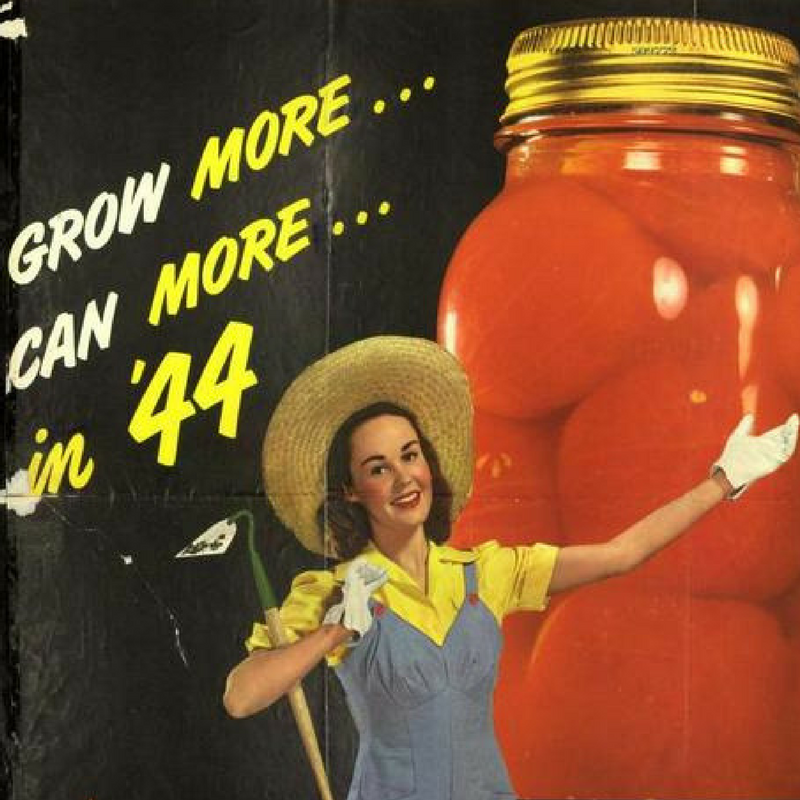
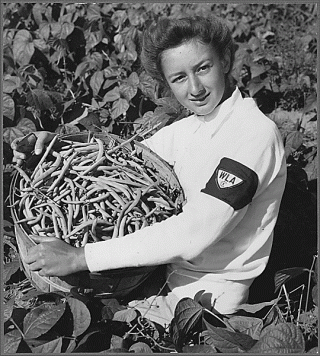
Elaine Norwich showing bushel of beans she just picked.
The events on December 7, 1941 catapulted the United States into World War II. The country’s entrance into the war meant many changes on the home front. Chief among these alterations was the introduction of food rationing in 1942. On January 30th of that year, President Franklin Delano Roosevelt signed into law the Emergency Price Control Act, which enabled the Office of Price Administration (OPA) to lay the ground work for food rationing, which was begun in the spring.
Food Rationing
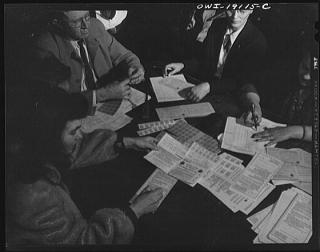
Signing up for sugar and food rationing in 1943
Under the food rationing system, everyone, including men, women, and children, was issued their own ration books. Rationed foods were categorized as either needing red or blue points. Individuals wishing to purchase foods under the red points scheme, which included meat, fish and dairy, were issued with 64 points to use per month. For blue points goods, including canned and bottled foods, people were given 48 points per person for each month. The OPA determined the number of points needed for goods based on availability and demand. The points values could be raised or lowered accordingly. Sugar was one of the first and longest items rationed, starting in 1942 and ending in 1947. Other foods rationed included coffee, cheese, and dried and processed foods.
The war placed additional demands on the agricultural sector to not only feed the home front, but also support US troops and fulfill America’s obligations to the United Kingdom and other allies through the Lend-Lease Program. The agricultural sector of the US economy expanded greatly from these added demands.
Women’s Land Army
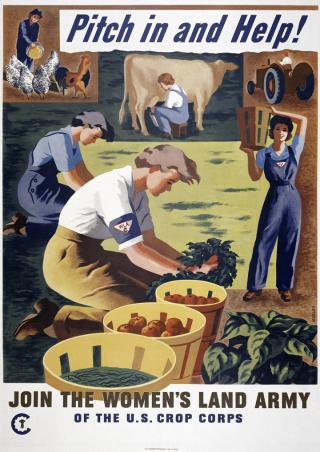
Poster from World War II
While the acreage under cultivation and agricultural yields increased throughout the war, many young men left the farm to join the military or work in another war industry. The United States Department of Agriculture (USDA) needed to identify new ways to fill labor shortages. On a tour of England in 1942, Eleanor Roosevelt spoke with members of the Women’s Land Army about their work in agriculture. She was encouraged by the positive results these women had on the agricultural outlook of Britain. Upon her return to the United States, she began lobbying for a similar system to be put in place. The USDA was reluctant at first to enact such a program. However, in 1943, Congress passed the Emergency Farm Labor Program, creating the Women’s Land Army of America (WLAA), or as it became known, the Women’s Land Army (WLA). It is estimated that 2.5 million women worked in the WLA during WWII.
Victory Gardens
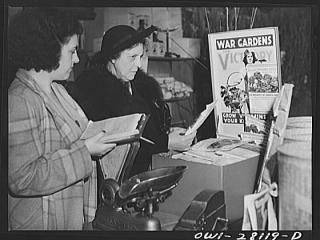
Buying seed for a victory garden.
The USDA encouraged people throughout WWII to grow their produce in family and community gardens, known as victory gardens. People were urged to plant gardens in rural and urban settings to offset the food rations, add vitamins to their diet, and support the war effort. Use of food through effective production, consumption, and preservation, was presented by the government as patriotic acts to help the troops and the nation. Historians estimate that by 1943 up to 20 million victory gardens were cultivated, helping sustain the needs of the country. Although wartime propaganda tended to portray gardening as a masculine activity, a wide variety of the population helped to grow produce, including women and children.
USDA Extension Services
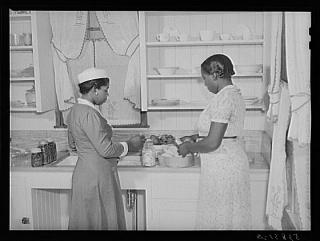
Canning squash during a canning demonstration.
The Extension Services of the USDA played a vital role in feeding families, troops, and allies in wartime. Created in 1914 by the Smith-Lever Act, the Extension Services was set up as a nation-wide organization of the USDA in conjunction with state land granted universities to support and educate rural communities about agricultural and domestic efficiencies. One of the key components of the organization’s work was to send home demonstrators such as Florence L. Hall (director of WLA in WWII) and Grace E. Frysinger to agricultural areas. Demonstrators educated rural families about home economics, particularly in relation to the wise use and preservation of food. Such work became particularly important in the wake of the Great Depression. Financial hardships in rural areas made food use and conservation extremely important. The USDA set up community canning centers as part of their efforts to help families suffering the economic effects of the period.
Canning
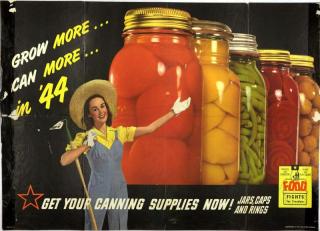
Poster from World War II
The Extension Services’ home demonstrators and canning centers once again became vital to those living on the American home front during World War II. Canning in wartime became a major focus of the US government. Women were encouraged to support their families and the nation by canning produce grown in their garden. Canning, like gardening, was presented in official propaganda as a patriotic and unifying act, linking soldiers’ activities to women’s roles in the kitchen. Government officials asked individuals to organize their garden activities in conjunction with the canning outcomes that they envisioned, urging them to “plan your canning budget when you order your garden seeds.” The interconnectivity of the two activities ensured that just as victory garden yields reached their peak in 1943, so too did canning levels. The USDA estimates that approximately 4 billion cans and jars of food, both sweet and savory, were produced that year. Community canning centers aided in the process of reaching record levels of preserved food in the United States during the war. In 1945, the USDA stated that 6,000 canning centers were in operation throughout the United States. These centers were locally sponsored and financially supported, but with instructional and educational oversight provided by the USDA. The government issued handy bulletins outlining the process of canning, including the use of water baths and pressure cookers for low acid food. It also provided guidelines as to cooking times and temperatures for the preservation of different foods.
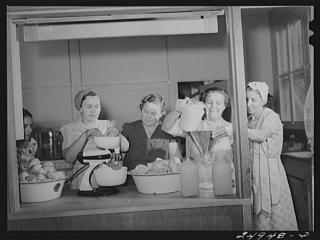
Canning grapefruit in a community kitchen.
Within the centers, a home demonstrator from the Extension Services or a locally qualified individual was on hand to supervise and instruct users in canning techniques. Individuals brought their raw produce to the center and paid a small fee or donated a small quantity of their preserved food in return for the use of materials. With the rationing of vital metal goods for the war effort pressure cookers were not produced for much of WWII. The centers offered women the opportunity to use this equipment if they did not have their own device or were unable to borrow from family or friends.
Sugar
Sugar was a major concern for canners throughout the war, whether they preserved food at home or in the community canning centers. A canner could submit an application to obtain up to 20 pounds of extra sugar for their preservation needs. However, this was not guaranteed and based on supplies sometimes women could not obtain this additional amount.
Today, the Extension Services continue to support people’s interest in food production and preservation. Branches of the organization offer courses on canning throughout the country and both women and men have shown renewed interested in conserving food.
Article
- Carpenter, Stephanie Ann. “‘Regular Farm Girl’: The Women’s Land Army in World War II.” Agricultural History 71 (1997): 162-185.
- Litoff, Judy Barrett, and David C. Smith. “To the Rescue of the Crops.” Prologue 25 (1993): 1-25. Accessed July 14, 2017. https://www.archives.gov/publications/prologue/1993/winter/landarmy.html
Audio
- Stoller-Conrad, Jessica. “Canning History: When Propaganda Encouraged Patriotic Preserves.” NPR, August 3, 2012. http://www.npr.org/sections/thesalt/2012/08/02/157777834/canning-history-when-propaganda-encouraged-patriotic-preserves
Books
- Bentley, Amy. Eating for Victory: Food Rationing and the Politics of Domesticity. Chicago: University of Illinois Press, 1998.
- Collingham, Lizzie. The Taste of War: World War II and the Battle for Food. London: Allen Press, 2011.
- Gowdy-Wygant, Cecilia. Cultivating Victory: The Women’s Land Army and the Victory Garden Movement. Pittsburgh: University of Pittsburgh Press, 2013.
- Office of Distribution, War Food Administration. Community Canning Centers. Washington: Unknown, 1944. https://archive.org/stream/communitycanning544unit#page/n5/mode/2up
- Toepfer, Edward W. , and Howard Reynolds, Howard. “Advances in Home Canning.” Washington: Unknown, 1943. https://naldc.nal.usda.gov/naldc/download.xhtml?id=IND43894002&content=PDF
- USDA. “Community Canning: Princeton, New Jersey Way.” Washington: Unknown, 1943 https://archive.org/stream/CAT31312233#page/n1/mode/2up
- USDA, War Food Administration. “The Facts about Home Preservation in 1945.” Washington: Unknown, 1945. https://archive.org/details/CAT31071164
Online Exhibition
- USDA, National Agricultural Library. “How did we Can?: The Evolution of Home Canning Practices.” Accessed September 8, 2017 https://www.nal.usda.gov/exhibits/ipd/canning/exhibits/show/wartime-canning
Papers
- “Frysinger, Grace E. (Grace Elizabeth), 1885-1973. Papers of Grace E. Frysinger, 1919-1956: A Finding Aid.” Radcliffe Institute for Advanced Study, Harvard University. Accessed July 22, 2017. http://oasis.lib.harvard.edu/oasis/deliver/~sch00589
Websites
- “Cooperative Extension History.” USDA, National Institute of Food and Agriculture. Accessed September 8, 2017. https://nifa.usda.gov/cooperative-extension-history
- Schumm, Laura. “Food Rationing in Wartime America.” History, May 23, 2014. http://www.history.com/news/hungry-history/food-rationing-in-wartime-america
- “Smith-Lever Act.” The National Archives Foundation. Accessed July 22, 2017. https://www.archivesfoundation.org/documents/smith-lever-act-1914/
Websites
- “Food Preservation.” Cornell Cooperative Extension, Warren County. Accessed September 8, 2017. http://warren.cce.cornell.edu/food-nutrition/food-preservation
- National Center for Home Preservation. Accessed September 8, 2017. http://nchfp.uga.edu/
- Roosevelt, Franklin Delano. “Statement on Signing the Emergency Price Control Act, January 30 1942.” American Presidency Project. Accessed September 8, 2017. http://www.presidency.ucsb.edu/ws/?pid=16192
